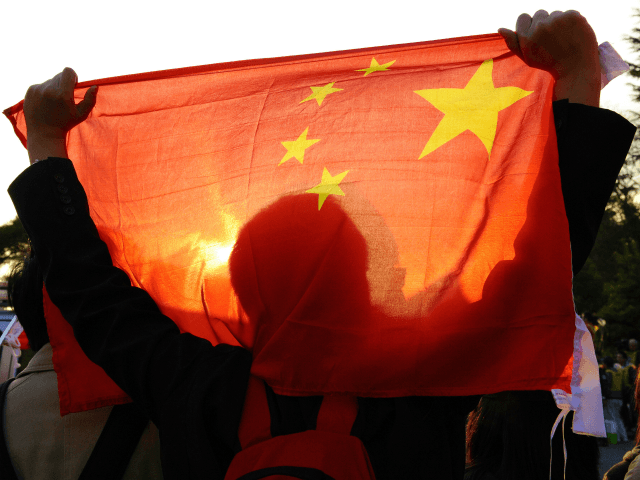A group of over 100 Chinese tourists swarmed Yagong Island, in the disputed Paracel Island chain of the South China Sea, this weekend for a “flag-raising ceremony” to assert China’s sovereignty over the region.
Vietnam and Taiwan both claim parts of the Paracel Islands, though China has largely colonized the chain. Some of the tropical reefs in the region now boast complete artificial islands equipped with advanced Chinese military equipment. Beijing insists that its development of the islands is legal and for civilian purposes despite a 2016 international law ruling finding China has no sovereignty over the region.
The South China Morning Post reported Monday that state propaganda outlets had posted images of the tourist brigade landing on Yagong and raising the red Chinese flag. The group sang the national anthem, “The March of the Volunteers,” and chanted pro-Beijing slogans as they raised the flag, according to the report.
The Post translated some of the remarks quoted in Chinese media from the participants.
“Finally my dream was fulfilled, and I feel very proud to be standing here looking at the Chinese flag,” one tourist, identified as Deng Runping, said. “Here I feel that we look very dignified and solemn, because it is the motherland’s most southern point.”
While Vietnam and Taiwan dispute various parts of the South China Sea, Vietnam only claims Yagong Island. The Vietnamese government claims it falls within the exclusive territory of Vietnam, though the country has not had control of the island since 1974, when the Chinese sent the People’s Liberation Army to invade and colonize it. The beleaguered Vietnamese government did not have the ability at the time to withstand the Chinese onslaught and, still dwarfed in military might by China, only gingerly challenges China’s claims to its territory.
The largest Chinese artificial islands in the South China Sea are in the Spratly and Paracel Islands. Vietnam lays claim to some of both, while the Philippines claims much of the Spratly Islands. China also claims territory belonging to Brunei, Malaysia, and Indonesia elsewhere in the South China Sea, but has not so aggressively imposed its will there.
The tourist invasion of Yagong is part of a larger, years-long effort to convince Chinese tourists to swarm the disputed territories of the South China Sea, making an active effort to maintain a Han Chinese presence in the region. China’s local administrators began campaigning to attract more tourists in 2016 as efforts to illegally construct artificial islands there escalated. That year, the New York Times noted, Paracel Island Mayor Xiao Jie told China Daily that the chain would begin introducing a greater selection of tropical cruises and wedding packages to attract mainland Han Chinese.
“We will develop some islands and reefs to accommodate a select number of tourists,” Xiao announced. Among the islands named as targets of the new cruise itineraries was Yagong Island.
A year later, China announced a new initiative to attract more cruise trips to the Paracel Islands through Hainan, its largest tropical resort. According to Quartz, “the trips include a stirring flag-raising ceremony on one of the Paracel islands and a documentary about how China bravely won full control of the chain from Vietnam in the mid-1970s.”
Vietnam has attempted to fortify its territory by expanding its diplomatic reach, hosting joint military exercises with the Philippines, allowing a U.S. warship to visit Vietnamese territory and generally welcoming closer ties to Washington, and reaching out to India for closer diplomatic cooperation. India shares a border with China where Chinese troops have illegally attempted to usurp territory, as well.
Individual Vietnamese people have also organized widespread protests against China, demanding that Chinese soldiers leave Vietnamese waters and stop harassing Vietnamese fishermen. Along with them, Philippine protesters have undertaken similar voyages to the region as the one by the Chinese this weekend, raising the Philippine flag over the Spratly Islands. The Vietnamese government has been more receptive to the protesters than the Philippines, where President Rodrigo Duterte repeatedly rejects the idea of confronting China.

COMMENTS
Please let us know if you're having issues with commenting.